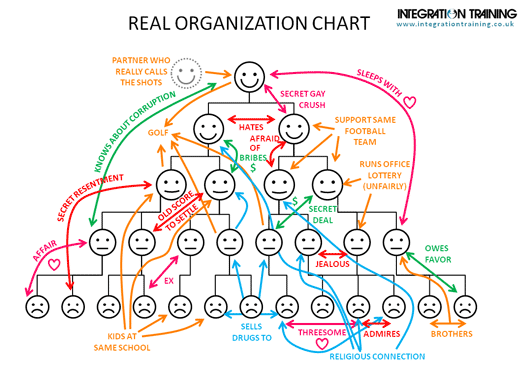Have you heard of Holacracy yet? If not, check it out. Put the word into google and you’ll get pages of theories, damning reports and glowing reviews. Get people talking about workplace bureaucracy and flattening organisational structures and you can see why it’s quite controversial. It’s certainly a quantum leap from anything you’ll have experienced before. I’ve just been on a taster workshop because I was curious.
And now I’m even more curious. So will it take off here in the UK and does it hold the key to the future structure of our organisations?
In the US, some have called it a radical form of “self-governing”. It’s certainly different and it’s certainly not for the faint-hearted. As if life wasn’t hard enough in any large organisation, to then ask everyone to completely change how they work, may well be enough to push people over the edge. Or would it? What would you make of an operating system where there are no job titles and no managers?
Yet Tony Hsieh, CEO of the hugely applauded US online shoe retailer Zappos, certainly liked the idea. So much so, that in 2014, it went holacratic. But what have the learnings been for them over the past 2 years?
My sense from reading many articles on this is that Tony Hsieh liked the idea that Holacracy because it put a huge amount of emphasis on consensual, democratic decision-making and getting everyone’s opinion. It was also a decision based on improving the administration of the organisation. Great, but can’t that get, well, a little messy?
Not once you get going. That was certainly my impression from the half-day experience I had during a recent workshop I attended with Evolving Organisation recently. There are more than enough detailed procedures to keep you right on track, however there is no denying that Zappos was already a pretty agile business. Medium, the blogging platform, set up by Twitter co-founder Ev Williams, adopted it too. But the bad news there is that they gave up on it in March this year, citing it as “time-consuming and divisive”. And how long that takes is another matter. It’s one thing adopting this in an early-stage startup, it’s another turning an existing organisation inside out to adopt it. Apparently it’s going to take Zappos 5 years to fully integrate.
Essentially, in Holacracy, there is a hierarchy of circles, which are to be run according to detailed democratic procedures. At the same time, each circle operates within the hierarchy. Each higher circle tells its lower circle (or circles), what its purpose is and what is expected of it. It can do anything to the lower circle—change it, re-staff it, abolish it—if it doesn’t perform according to the higher circle’s expectations.
Flattening workplace hierarchies has been a management trend for several years, it’s accrued its proponents and detractors. The argument for such a radical break from tradition is that so-called “flat” workplaces are in theory more likely to spark unlikely collaborations, which in turn can lead to creative new initiatives. Yet unlike some of its contemporaries, Holacracy doesn’t advocate for a flat organization. Rather, it organises work and people around circles within circles within circles. People within those circles have “roles” that give certain team members complete control over their domains. Someone at Medium, for example, was in charge of fonts and made all font-related decisions. Medium still had managers, because each circle in holacracy has a leader. But unlike a traditional manager, not all decisions have to go through that one person, and that person can change because the structure is very fluid and is why people don’t have titles. Instead they have roles that often change.
The main objective is to distribute authority throughout an organisation. Fewer decisions bottleneck through a boss, meaning faster decision-making and in theory faster innovation. All of that makes Holacracy particularly appealing to companies that want to retain the benefits of fast-moving startups as they grow.
There is no doubt that implementing Holacracy in a large organisation is not going to be cheap or easy. In fact, last year, Tony Zappos told his staff to ‘accept Holacracy or leave’. It shot their staff turnover rate up to from 20% 30%, in 2015 (although they cited many reasons for this, not just Holacracy). At the beginning, there’s not doubt it can be chaotic and as I mentioned above, the process is going to take them 5 years to fully adopt.
But certainly, if a top-down structure isn’t for you, then this is an alternative you should seriously consider, particularly if you’re a business on the smaller side. After all, the hierarchical organisation dates back to the industrial revolution, when companies wanted to preserve accountability while employing large numbers of people. Yet the relationship between manager and employee has organically shifted over the last few decades. Almost half of the CEOs interviewed for a 2015 report by the London brand consultancy Wolff Olins said they had structured their companies to give employees more autonomy.
Personally I can’t wait to see if all the pain has been worth it at Zappos and I have real hope that it will be stronger as a result. For my part, I think there are huge learnings from Holacracy. It may be too big a leap for most organisations, but that doesn’t mean that lessons can’t be drawn from it.
Am I tempted to put this in place with my own two companies, as they are at such early stages? Yes actually I am, and writing this piece is the beginning of a more thorough investigation. Hierarchical structures do work, in the main because not everyone wants to be the boss, or have such a level of responsibility. But startups need to attract strong, adventurous, curious people from the outset who are prepared to take responsibility for their actions and appreciate the importance of their input. I’ve never been an ivory tower MD. There may be many reasons for that, but mostly it’s because I think it works to give people responsibility and a real say in how the business is run. Indeed I have tried it and it does work. It gives purpose and meaning to both individual and organisation.
Read more about how Holacracy works here and here’s a quick-start guide to give you a flavour of what you’re in for .
Here’s how Zappos are doing it.
By Justine Clement

